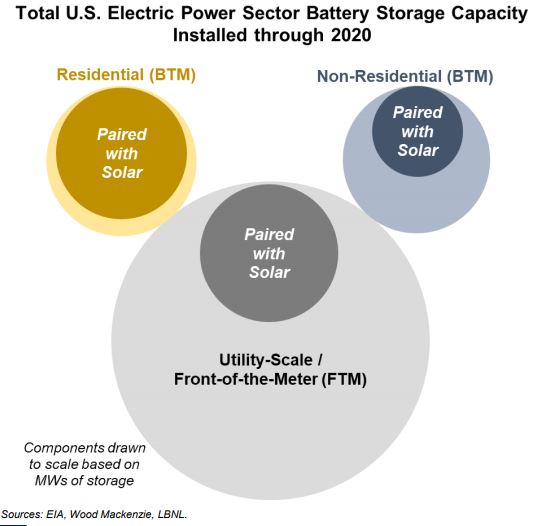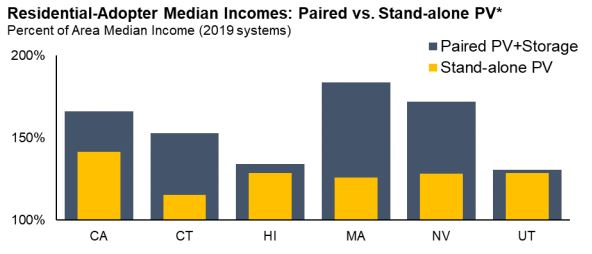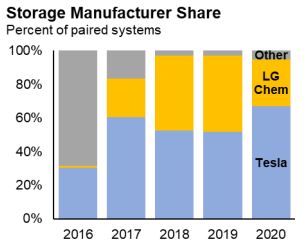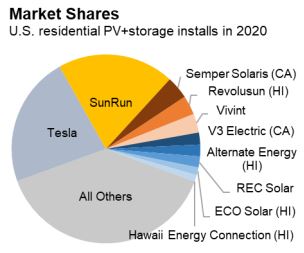Energy storage paired with solar in “behind-the-meter” (BTM) applications reached roughly 550 MW in 2020, representing about 17% of all U.S. battery storage capacity installed during the year, according to Lawrence Berkeley National Laboratory (LBL).
Berkeley Labs reports residential installations made up about two-thirds of all solar-storage BTM capacity, partly because almost all residential storage is coupled with solar.
Roughly 3,200 MW of storage capacity was added in the U.S. through 2020. Roughly 1,000 MW (30%) was behind-the-meter, and of that, 550 MW was paired with solar. Residential storage was coupled with solar in 80% of projects, while non-residential BTM storage included solar in 40% of all projects. Around 19% of all utility-scale/front-of-the-meter storage capacity was paired with solar.

Image: Berkeley Labs
Battery attachment rates
Despite growth nationally, storage attachment rates of BTM solar installs remain low, the report said, with 6% of residential, and 2% of non-residential systems choosing to attach batteries at install.
Some states and utility territories had much higher storage attachment rates, especially Hawaii. There, roughly 80% of all residential and 40% of non-residential PV installations were paired with storage in 2020. The attachment rate was attributed to the state’s transition away from net metering.

Image: Berkeley Labs
California also showed relatively high attachment rates, driven by a combination of direct cash rebates for storage equipment, and by concern related to wildfire-driven power outages, said Berkeley Labs.
Customer segments
 Income had some correlation with storage attachment rates at the residential level, the report said. In California, PV+ storage residential customers had median incomes 66% higher than their area median income, while stand-alone PV adopters were 41% higher.
Income had some correlation with storage attachment rates at the residential level, the report said. In California, PV+ storage residential customers had median incomes 66% higher than their area median income, while stand-alone PV adopters were 41% higher.
Schools made up a markedly larger share of PV + storage systems (25%) than for stand-alone PV (8%). Berkeley Labs attributed that to a unique value for resilience, and relatively large loads for the sector.
Storage retrofits
Retrofits, or the addition of batteries to an already-active PV system, did not occur with relative frequency, except in California. For residential systems, 25% of paired systems were retrofits, and 38% of non-residential solar + storage facilities were the result of a retrofit.
Storage retrofits were being added to PV systems of all ages, but typically ware installed on systems that were less than three years old. In about 10% of all retrofits additional PV capacity was added, the report said.
Configurations
Berkeley Labs said the residential storage market was dominated by two brands in 2020, the Tesla PowerWall, a 5 kW/ 13.5 kWh, 2.7 hour unit, and the LG Chem, a 5 kW/ 9.3 kWh, 1.9 hour unit.
Most residential systems consist of a single battery, though the share of multi-battery installations has nearly doubled from roughly 20% to 40% from 2017 to 2020. PV systems paired with storage tend to be slightly larger than stand-alone systems, with the median case being roughly 1 kW larger in size.
roughly 1 kW larger in size.
On the non-residential size, there was a greater diversity of battery suppliers, though the Tesla Powerwall commanded roughly half of the segment. Storage sizing in paired applications ranged widely, but the median values were 100 kW and 200 kWh, and most batteries were about two-hour duration.
PV systems in paired applications were generally much larger than stand-alone in the non-residential BTM market, with a median system size of 200 kW for paired vs. 40 kW for stand-alone.
Installers
BTM installers were increasingly found to offer storage along with their solar installations. In 2020 50% of all active residential installers reported completing at least one paired project. The report said that the market for solar plus storage remains considerably more concentrated than that of stand-alone solar.
Ten firms comprised roughly 60% of all U.S. residential PV and storage installs in 2020. Sunrun and Tesla each accounted for about a 20% share. Most others in the top 10 were local firms in Hawaii and California.
 Installer-level attachment rates varied from firm to firm in California, suggesting a wide array of divergent business and marketing strategies.
Installer-level attachment rates varied from firm to firm in California, suggesting a wide array of divergent business and marketing strategies.
Non-residential BTM solar-plus-storage remained relatively specialized, the report said, with about 17% of firms having completed at least one system through 2020. Tesla stood out with more than 200 cumulative installations, though in recent years its market share has shrunk to 10%, the report said.
Storage price premium
Berkeley Labs synthesized data from National Renewable Energy Laboratory studies, Tesla online quotes, the WoodMackenzie monitor report, and other sources to arrive at typical price figures for including storage with a BTM system.
It found that the incremental cost of adding batteries to PV averaged about $1,ooo/kWh of storage. This varied by source from about $700-$1300/kWh, and ranged much more widely for individual projects. The installed price-premium for residential PV landed at $1.20/W, with sources ranging from $1.15-$1.50/W, and individual projects also showing a much wider price premium range.
Berkeley Lab also analyzed the value-to-customer of adding storage. It was found that the benefit depended largely on which utility service area and state the project was located in. On average, the financial value of adding storage was estimated to be $500-$1000/kWh.
Berkeley Labs said this finding suggests co-adoption was likely driven by non-financial considerations, like the value of resilience during power outages.
By contrast, on the non-residential side, the customer-economics fared better. The report estimated present-value benefits ranging from $1,200-$2,000/kWh. This was due partly to the availability of accelerated depreciation, and partly to the fact that these buildings can avoid relatively high electricity demand charges by using smart storage export techniques.
LBL also analyzed how much backup power can be expected from a residential system. It found that a standard configuration 7 kW system paired with 5 kW/10 kWh battery storage could serve, on average, about 60-80% of a customer’s daily consumption over the course of a year. These values vary seasonally, and vary even more dramatically on a day to day basis due to cloud cover.
This content is protected by copyright and may not be reused. If you want to cooperate with us and would like to reuse some of our content, please contact: editors@pv-magazine.com.









By submitting this form you agree to pv magazine using your data for the purposes of publishing your comment.
Your personal data will only be disclosed or otherwise transmitted to third parties for the purposes of spam filtering or if this is necessary for technical maintenance of the website. Any other transfer to third parties will not take place unless this is justified on the basis of applicable data protection regulations or if pv magazine is legally obliged to do so.
You may revoke this consent at any time with effect for the future, in which case your personal data will be deleted immediately. Otherwise, your data will be deleted if pv magazine has processed your request or the purpose of data storage is fulfilled.
Further information on data privacy can be found in our Data Protection Policy.